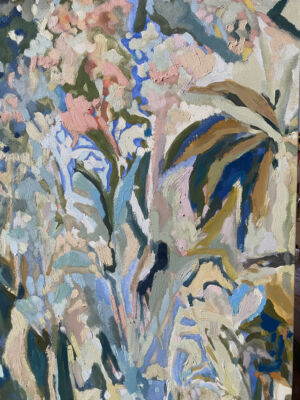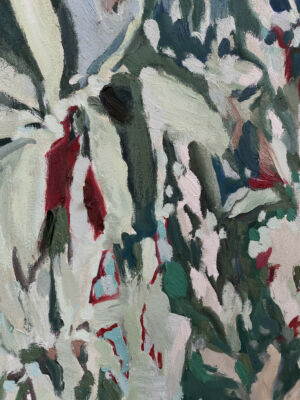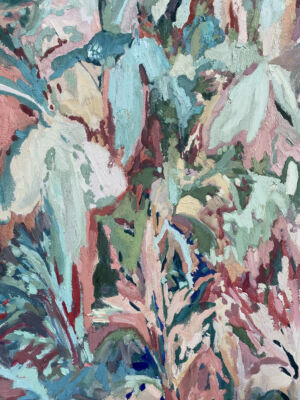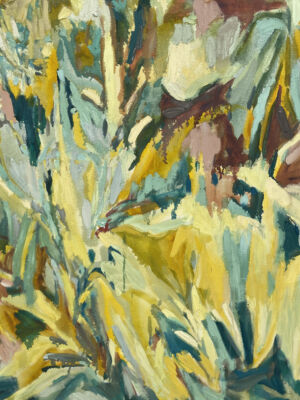Beatrice Hasell-McCosh
‘andante’
Curated by Jenn Ellis
Exhibition July 3 – 27, 2024. Saint Cyprian’s Church, Glentworth St, London NW1 6AX

Beatrice Hasell-McCosh in her studio in London, 2024
Beatrice Hasell-McCosh‘s work uses natural form as the lens to explore emotional themes, identity linked to place and human connection. Drawing is vital to her practise and she uses closely observed studies made from life to make large-scale paintings in her studio. She works as much from memory as from the studies and, in playing with scale, the focus of importance gives way (from direct figurative representation) to a flattened abstraction of those shapes with aesthetic choices relating to composition, texture and gestural use of colour taking on the primary importance. With a degree in English and Classics reading widely around a subject is important to her practise. The titles of each large work cite the disparate elements of this research from literature to pop culture, song lyrics and art historical links.
Hasell-McCosh’s recent work is a series of monumental paintings around the themes of emotions associated with geographical identity, time and place. She has continued with the concept of work presented in various parts (a motif which began after a trip to Japan in 2018). Kintsugi and the idea of beauty in imperfection has been significant in her thinking since then and it is seen in a number of her works where the different elements of the triptych or diptych are uneven. As a twin she is also naturally attracted to multiple parts that make up a whole and most often the form of her work is in diptych.
During the global pandemic the reassuring continuity and cycle of nature became completely absorbing to the artist who watched and drew from the same spots continuously seeing plants grow up crowd together, bloom and die, and being replaced with the new. When working in oil the scale changes dramatically from the original watercolour imagery and the painting becomes much more about the material fact of the paint rather than the subject with the negative shapes expanding the architectural structure of the marks. Her influences are wide ranging, from music to Disney productions set design, comic book strips, 1950’s adverts, Chagall’s stained glass, the freezing of a moment in poetry and the traditions of tapestry and wallpaper design.
Beatrice Hasell-McCosh Interviewed by APSARA
‘Flowers and colour already represent so much and have different meanings in different cultures. It adds depth to the work for me when I’m able to bring in these additional references.’
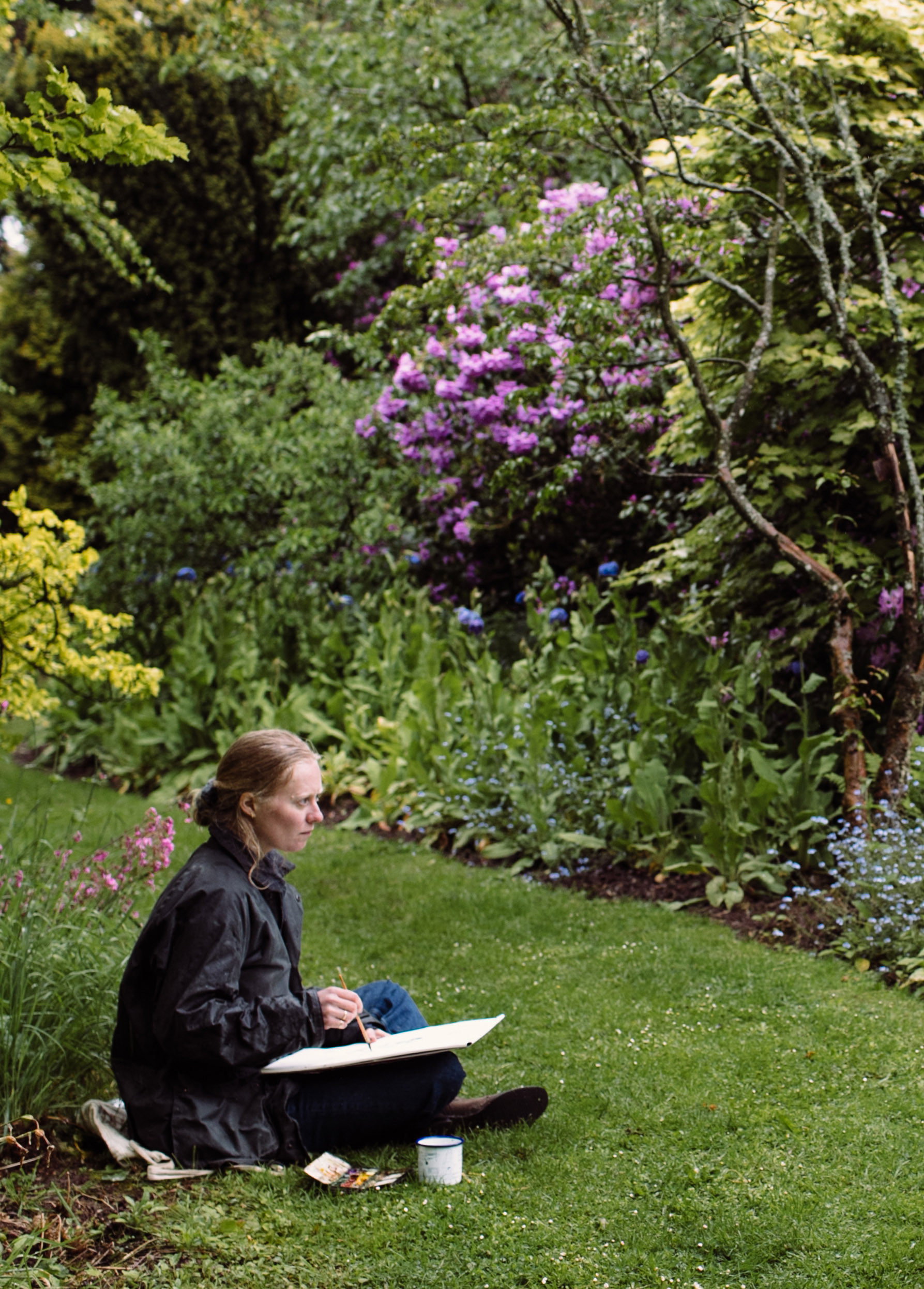
We are extremely excited to be working together on your next solo at St Cyprian’s Church in London. More so, we were impressed to get to know a pluralistic world of inspiration you draw from that includes Classics, phytology, botany, poetry, comic book strips and tapestry, to name a few. Could you tell us a bit about your background and which of these interests you will tap into for this exhibition?
I studied at Leith School of Art in Edinburgh and then the Royal Drawing School in London but before that my degree was in English and Classics at University so reading widely around a subject was quite a natural element of my practise when I started painting. Flowers and colour already represent so much and have different meanings in different cultures. It adds depth to the work for me when I’m able to bring in these additional references.
Current interests include historic wallpaper and tapestry – I love the Hardwick Tapestries in the V & A which are in this huge church-like, darkened room up in the top of the building. I love murals too, anything on a large scale which gives the feeling of being enfolded by a world. In the same way I love light installations such as work by James Turrell, or architectural space – Tadao Ando buildings on Teshima Art Island were extraordinary to be inside.
With my own paintings, they begin with small drawings, done from life. These then act as reference points for larger paintings done in my studio in London, mostly from memory. The drawings sit in a plan chest and I bring them out over a period of time to draw inspiration from. It’s become harder and harder to let these go as they can galvanize thoughts and new work even years after I first make them.
You are not only an artist, but a visual botanist whose practice blends a scientific knowledge of plants with a sensitivity to our relationship with the living world. How does a visual botanist observe and experiment in attempt to investigate and collide the intersections of science, the natural world and art?
It’s really kind to be described as a visual botanist, ironically In real life i am worryingly bad at keeping plants alive. I like the concept of collection of knowledge though, like historic plant hunters. My mum is an extraordinary and creative gardener and her passion and knowledge was something very cool to be able to connect with during 2020 when I spent so much time drawing in the garden at home and collecting information. I was tapping into her extensive experience and knowledge and thought process for constructing the garden and my works are reactions to all this information, trying to create that same feeling that someone else can then experience in a different way.
Visually, your references to botany and pattern could be seen as linked to a tradition that recalls the Arts and Crafts movement, in particular, the works of May Morris. Politics were at the centre of Morris’ work. Do you see your own work as political and/or what is its societal engagement?
I do think that all art has something to say and engagement with the world you live in is important. This engagement is also something that happens fairly naturally, i’m a woman living in the world today and there’s a lot to talk about.
What I like is the dichotomy between often uncomfortable political thoughts and the ‘pretty image’; to be drawn in by colour and texture and to stay for the back story of the art historical, contemporary culture or feminist references. May Morris was good at this; using needlework and embroidery, docile domestic crafts (a ‘womans hobby’) to pack a feminist punch and to strive for equality.
‘Stay Sexy & Don’t Get Murdered’ is an example of this, the title of the work is from a Ted talk by Jason Katz about violence against women being a passive action that women allow to happen. It’s a striking soundbite and yet the painting is made of pinks and soft bright colours which have been historically linked with ‘the fairer sex’, weakness or feelings of delicacy. I have purposefully muted these colours and when you get up closer it feels much greyer, less vibrant and more complicated than on first view.
You mentioned you’re inspired by Kintsugi and the idea of beauty in imperfection. How is your artistic approach shaped by this sensitivity and methodology?
When I begin I never have a solid idea of what a work will look like. The mistakes, drips and shapes that emerge during the first laying down of paint then inform the structure of the marks as I go along. The only thing I know from the outset is colour choices and I usually work with a limited palette of 3 or 4 colours per work. The architecture of the negative shapes is something that is important in the final work as much as the recognisable figurative elements. Imperfection and the unplanned is often the thing that brings a work together at the end which is why it’s beautiful.
Being in your studio, we were struck by the mixed emotions one feels when confronted by the immersive and at times grotesquely populated world of your large-scale canvases, in contrast to the delicacy of your watercolors. Could you talk about emotionality regarding the senses’ responses to color, shape and form?
I wanted to create worlds within worlds, something that takes over the viewers senses and immediate surroundings. Completely covering the canvas from corner to corner is therefore crucial to creating this experience. The layers of impasto paint add to this first impression of abundance. Colour provides a synthetic accessibility (the use of light bright colours often found in comic books or adverts) and then the heft of the shape and space within the painting co produces a narrative with the viewers own take on their experience of being in front of the work.
Painting is a way of processing things. For me it’s really like a form of meditation. This year has been extremely turbulent because of family illness. I have used painting as a way of processing thoughts and, also (in the same way you step out of your own world when you watch a film) it is a way of being elsewhere for a short time. My colours have become much brighter, having previously been full of earth tones, perhaps this is a form of manifesting positivity as well.
Thinking of St Cyprian’s Church, not just architecturally, but also as a place of deep reflection and communal being, how will the exhibition respond to the idiosyncrasies of the site?
I’m excited to share the form of the show and Jenn’s curation, each work will be freestanding like separate life forces or windows into various worlds.
Being in a church is also extremely relevant to the origins of the paintings as well. During lockdown people weren’t able to go to churches, which were closed, instead nature and gardens became something that people (and I) aspired to almost worshipped in the news. Rightmove searches for houses with gardens went up 200%. Works done then in diptych form were referencing altar pieces – the Ghent Alter piece particularly – where multiple shaped parts make up a whole.
The mediation aspect of drawing and being in nature was something I found comforting during that period of time and as the paintings developed it also allowed me the space and opportunity to grow my work in scale and concept. Being at St Cyprians Church allowed for large scale imagination for the curation which is expansive and exciting.
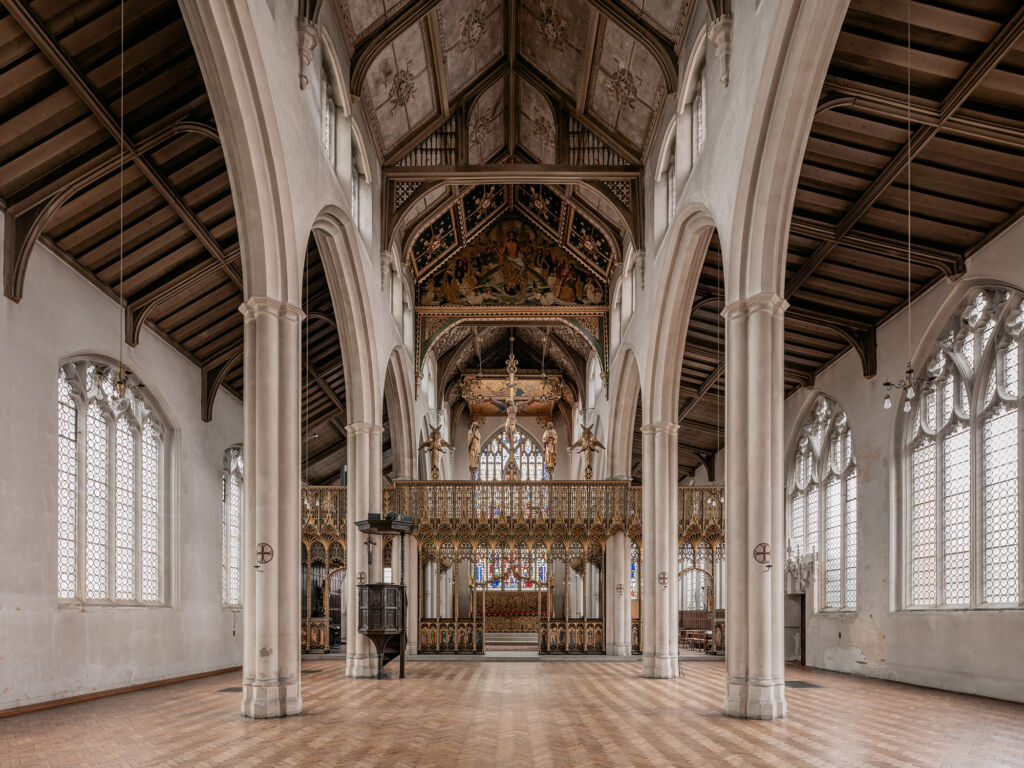
Saint Cyprian’s Church. Marylebone, London.
Hasell-McCosh lives and works in London. studied English and Classics at Leeds University and then spent two years studying at Leith School of Art in Edinburgh and The Royal Drawing School in London. Her work is in private collections around the UK, around Europe, Japan and the USA. Most recently her work has been acquired by the Royal Collection Trust and the Garden Museum. She has curated two exhibitions, both focusing on the importance of drawing. Her first museum solo presentation was at the Garden Museum in London in June 2022.
